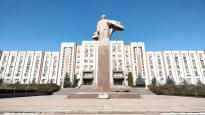No UN member state recognizes Transnistria’s independence. Russia keeps soldiers in the country, which it calls peacekeepers.
25.4. 20: 59 • Updated April 25. 21:38
There were several explosions in Moldova’s Transnistria today near the region’s administrative buildings, according to both the local TSV news channel and the Russian state media.
TSV showed a picture of the damaged buildings as well as the weapons possibly used in the attacks, such as grenade launchers.
The authenticity of the images and data could not be verified.
What is the region of Transnistria?
Transnistria is officially part of Moldova. It is just under half the size of Uusimaa and has an estimated 350,000 inhabitants.
Transnistria declared independence in 1990, but no other country has recognized its independence. After Russia conquered the Crimean peninsula from Ukraine in 2014, Transnistria announced its desire to join Russia.
What is its relationship with Russia?
Russia considers Transnistria to belong to Moldova, although it has close relations with the region.
Almost a third of Transnistria’s population is Russian-speaking.
Although the results of the 2006 referendum, in which 97% of those who voted expressed their support for independence and accession to Russia, have been considered fraudulent, a significant proportion of the Transnistrian population is genuinely pro-Russian.
The Russian-mindedness has its roots in the language disputes that were seen during the break-up of the Soviet Union. During the Soviet era, Transnistria, along with the rest of Moldova, was part of the Soviet Socialist Republic of Moldova.
At the beginning of the Soviet Union, Moldova declared Romanian the official language of the whole country. This Transnistria was not accepted and a war broke out between it and Moldovan government forces, which eventually ended with the intervention of the Russian army.
Transnistria has retained many Soviet-era symbols, such as the sickle and hammer and Soviet uniforms.
There are several Russian soldiers in Transnistria who Russia claims to be peacekeepers. However, the Council of Europe considers them occupiers of the territory officially part of Moldova.
